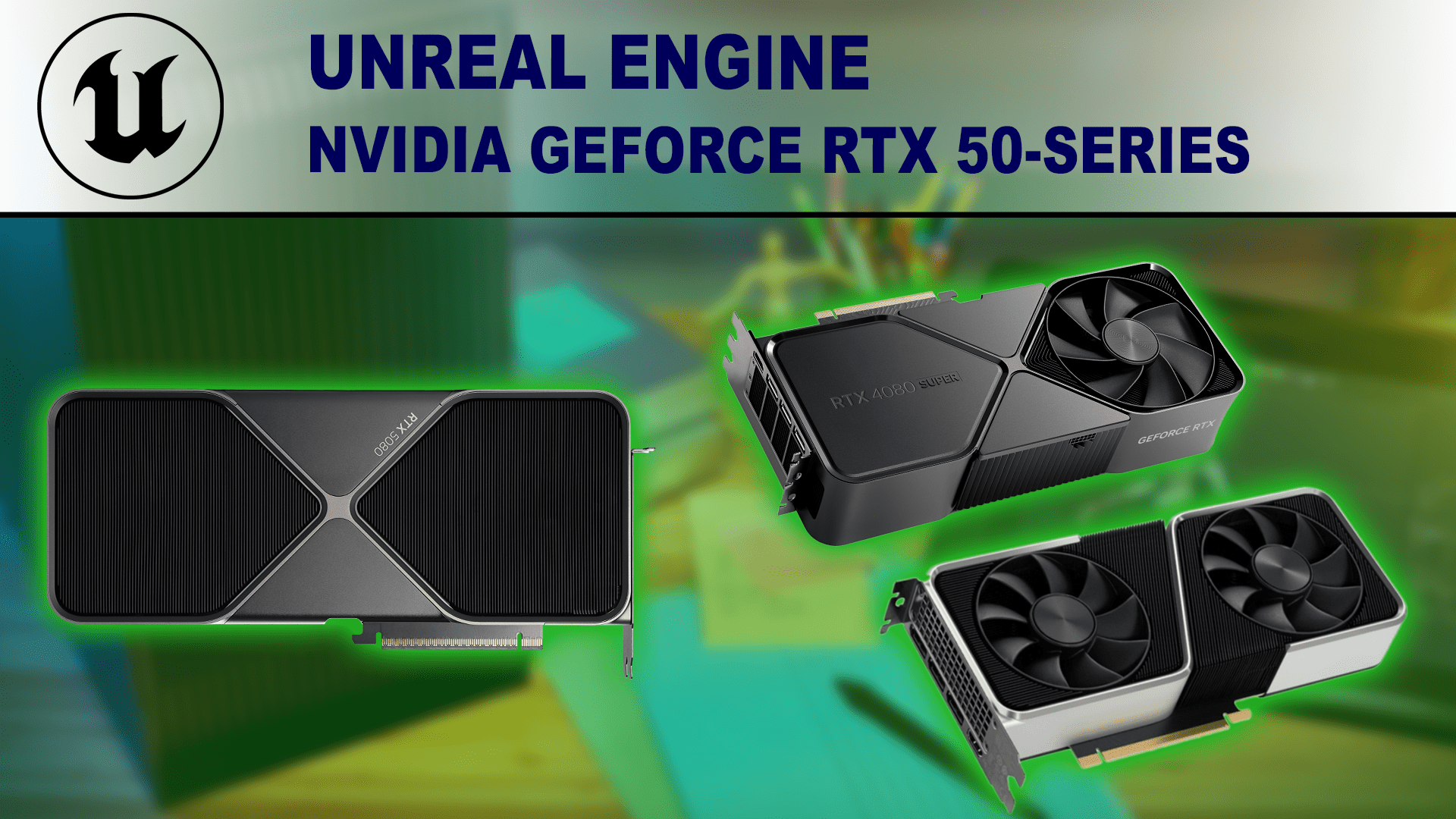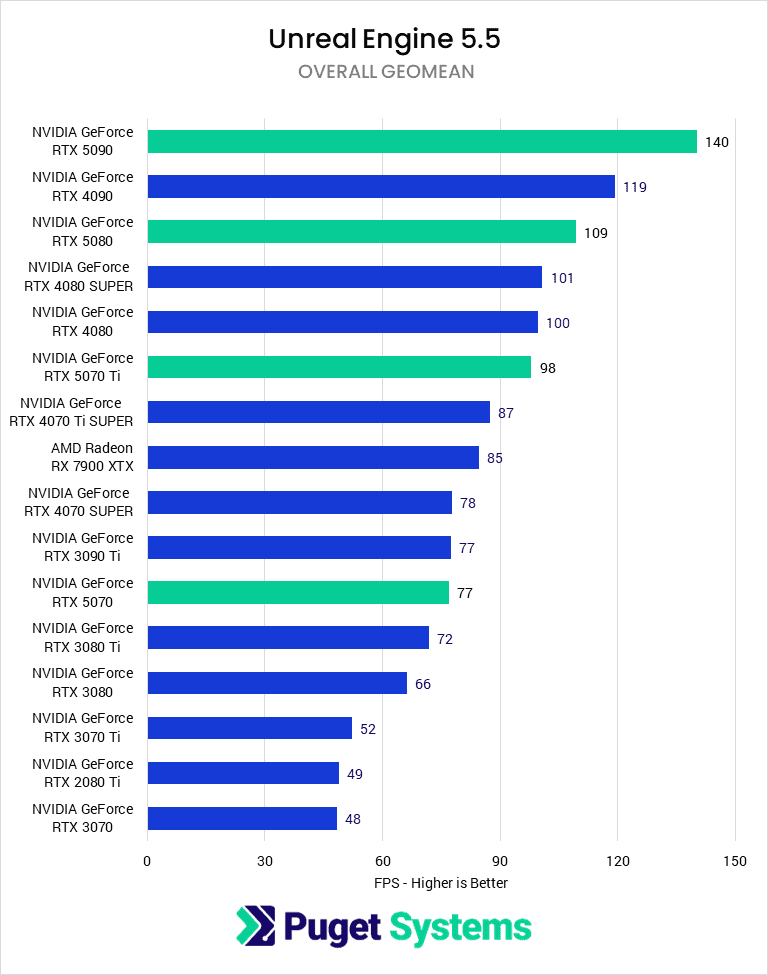Table of Contents
TL;DR: Should you use NVIDIA GeForce RTX 50 Series GPUs for Unreal Engine?
The NVIDIA GeForce RTX™ 50 Series GPUs deliver improved performance and ray tracing capabilities, making them a compelling option for 3D artists, game developers, and filmmakers. Game developers should consider their target audience’s hardware before upgrading. Those relying on GPU Lightmass or needing more VRAM for multitasking will benefit most from the RTX 5090, which offers a speed boost and 32GB of memory.
For virtual production, the RTX 50 Series enhances real-time rendering and scene complexity, particularly for those working with Unreal Engine. Filmmakers can leverage the additional power for more detailed environments, but professionals using LED walls for in-camera VFX will need to wait for NVIDIA’s next ProVis series.
Overall, the RTX 50 Series is a strong upgrade for users with aging hardware but may not be essential for those already on high-end 40 Series GPUs.
Introduction
In the fast-paced world of computer hardware, there’s always something new on the horizon. Keeping up with evolving software and workflows is already challenging, so many artists don’t have the time to track every new CPU or GPU release. At Puget Systems, we strive to simplify these advancements and explain their impact across various industries. Since hardware decisions can be complex, we recommend speaking with one of our consultants for expert guidance on building a system tailored to your needs. In this article, we’ll explore NVIDIA’s latest GeForce RTX™ 50 Series graphics cards and their potential impact on 3D workflows – including modeling, animation, and rendering.
NVIDIA’s GeForce RTX series has long been a leader in computer graphics technology, and the newly launched RTX 50 Series pushes the boundaries even further. These GPUs deliver substantial gains in performance and ray-tracing capabilities. While the lineup includes several models, the most relevant ones for 3D artists and content creators are:
- NVIDIA GeForce RTX™ 5090 32GB
- NVIDIA GeForce RTX™ 5080 16GB
- NVIDIA GeForce RTX™ 5070 Ti 16GB
- NVIDIA GeForce RTX™ 5070 12GB
These GPUs feature the latest advancements in AI-driven denoising, ray tracing, and CUDA core performance, making them highly valuable for a wide range of professional applications.

The RTX 50 Series cards have several improvements over previous generations and some specialty features like additional hardware video encoders. If you want a full breakdown of what is new with these GPUs, and a detailed performance analysis for a range of applications (including Unreal Engine, DaVinci Resolve, and After Effects), we have in-depth technical articles available for each GPU: RTX 5090, RTX 5080, RTX 5070 Ti, and RTX 5070.
However, in this post, we want to keep it high level and answer how much performance these new video cards may give you if you are considering upgrading from a fairly recent system (~1-2 years old) or an older system (3+ years). We have divided this article up by workflow, so feel free to jump directly to the section that most closely applies to you.
A Note on Performance
Our Unreal Engine benchmark is still a work in progress. Given the many updates to Unreal Engine, we don’t have numbers that can be directly compared across numerous generations of GPUs. Unreal Engine 5.5 brought many changes, including MegaLights and improved hardware ray tracing. This article only looks at the GeForce RTX 50, 40, and 30 Series and a single GPU from the 20 Series. We’ve also included AMD’s Radeon RX 7900 XTX, as some game developers are interested in AMD support.

Our current testing suite is focused on viewport performance, but we are actively looking to add Path Tracer testing, Megalights, and possibly some DLSS testing. We are also building a version that will be available to the public, so keep an eye out for that.
GeForce RTX 50 Series for Game Development
Game developers may be looking at these new GPUs for two different reasons. One is the desire for better GPU performance. If you rely on GPU Lightmass and are tired of waiting around for it to complete, you can see how much time could be saved and what the required investment in a new video card would be to get there. The RTX 5090 is 18% faster than the 4090, while the RTX 5080 and 5070 Ti only provided 10% more frames than their predecessors. Looking at even older hardware, the 5090 is almost twice as fast as a 3090 Ti, and three times as fast as the 2080 Ti. Users on the 40 Series may or may not find that performance bump worth the cost, but those on 30 Series and older cards will see dramatic improvements.
Another reason to look at video card options is when buying a new system – for example, if improved CPU performance is desired or a failing system is being replaced – but where you don’t necessarily need more GPU power. In that situation, the performance chart above helps ensure you get the best value. For example, if you currently have an RTX 2080 Ti and already get acceptable framerates in your game then you don’t need to splurge on a 5080 or 5090. Instead, you might find that an RTX 5070 or RTX 5070 Ti is good enough – allowing you to divert money to other components like a faster CPU.
Lastly, an important factor for developers to consider is video memory (VRAM). Even if your game engine isn’t consuming all of the VRAM by itself, you may have a 3D modeling application open or several Chrome tabs with tutorial videos, etc – so you may want more VRAM than your target audience would need. Only the RTX 5090 saw an increase in VRAM this generation, now offering 32GB.
GeForce RTX 50 Series for Virtual Production
Much like Game Development, Virtual Production is a broad umbrella with numerous different roles. It can involve anything from an artist making assets in the VAD to a cluster of nodes powering massive LED walls with real-time graphics and motion tracking.
LED Walls used for In Camera VFX (ICVFX) are one of the most visible forms of Virtual Production. However, one of the base requirements for this workflow is using NVIDIA’s Quadro Sync 2 card. Unfortunately, GeForce does not work with Sync – so these users must wait for the next generation of the ProVis cards which were just announced by NVIDIA at GTC. Typically, the performance of ProVis cards is fairly comparable to that of GeForce – though much more expensive – so the chart above can still give you a rough idea of what could be expected.
Filmmakers using greenscreens or rendering directly from Unreal may find the RTX 50 Series improvements beneficial. For many of these users, additional FPS isn’t exactly what they are looking for because they operate at a locked framerate. Instead, this extra processing power can be translated to 20% more detailed environments. The extra VRAM available in the RTX 5090 could also be very useful for higher-resolution textures, more geometry, and so on. Artists currently using a 4080 or 4070 variant have less reason to upgrade, as the 5080 and 5070s offer only modest increases in performance (~10%) over the previous generation.
Who is the NVIDIA GeForce RTX 50 Series for?
The NVIDIA GeForce RTX 50 Series brings notable performance improvements, but whether it’s the right upgrade depends on your specific workflow and current hardware.
For game developers, the 50 Series brings anywhere from 18% faster performance with the RTX 5090 to 10% with the RTX 5070 (compared to equivalent 40 Series models). If you are currently struggling with GPU-based workflows, such as GPU Lightmass or rendering cinematics, then this might be enough to get you to upgrade. Users of the 30 or 20 Series will see more significant performance improvements. Those looking to buy a new system to improve CPU performance for compiling code but who don’t need much more GPU power will get the performance of a top-of-the-line 30 of 20 Series card at a fraction of the cost.
The RTX 50 Series offers advantages in certain areas for virtual production, particularly for filmmakers rendering directly from Unreal Engine. The added processing power can enable more detailed environments, and the RTX 5090’s extra VRAM is beneficial for high-resolution textures and complex scenes. However, those working with LED walls for in-camera VFX will need to wait for the next generation of NVIDIA’s ProVis cards, as GeForce GPUs do not support Quadro Sync 2.
Ultimately, the RTX 50 Series is best suited for professionals who need more power for demanding 3D workflows but may not be a necessary upgrade for those already using high-end 40 Series GPUs. If you’re unsure whether upgrading is worth the investment, benchmarking your current system against the latest hardware can help guide your decision.
Finding the perfect workstation doesn’t have to be complicated. Explore our solutions page for a curated selection of recommended systems for a multitude of applications and workflows, or visit our custom configuration page if you already know the ideal hardware for your needs. If you need assistance with tailoring a system to a unique workflow or have any other questions, we encourage you to reach out to our dedicated technology consultants.

